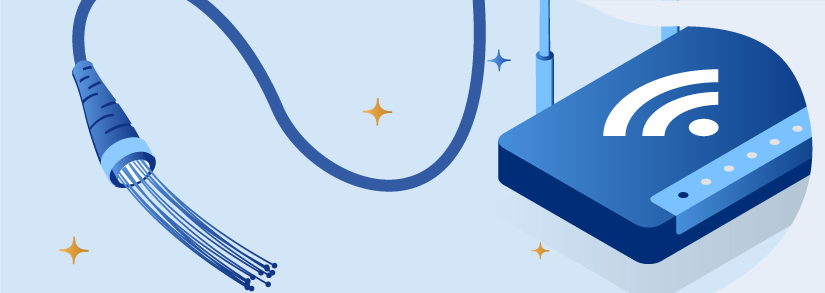Why You Should Switch To Fiber Broadband

The introduction of fiber optic technology has compelled internet service providers to step up their game and supply consumers with broadband speeds that are compatible with their technological initiatives. Emerging innovations have propelled us into a hyper-active digital world, as well as a fast broadband connection is an urgent requirement for nearly every person on the planet.
What Is Fiber Broadband?
Individuals can connect to the internet via a variety of methods, including mobile data or a broadband connection. On the other hand, fibre-optic networks have exploded in popularity since their introduction onto the market, and deservedly so.
Simply said, fiber internet allows you to surf the internet by using fiber-optic cables that are packed with glass filaments. These connections use lasers and light signals to transmit data back and forth.
Fiber-optic cable transports light extremely effectively over relatively long distances with little absorption and deformation of the light signal.” – Frank Cornett, a former Intel electronic engineer.
Furthermore, fiber connections are less distorted across long distances than copper-wire connections. Fiber-optic internet links, in essence, transport data using modified light rather than electricity. They are not constrained by the physical limits of electricity flowing through metal, so they have considerably more bandwidth capacity.
Currently, the top providers who offer fiber broadband are Jio, ACT and Airtel Xstream.
How Does Fiber Broadband Work?
Fiber cables are composed of a large number of tiny optical fibers. These fibers are incredibly thin, just under a tenth the thickness of human hair. They are tiny, but they have a lot more going on.
Every optical fiber is made up of two parts:
- The Core: Typically composed of glass, the core is the deepest section of the fiber through which light flows.
- The Cladding: The cladding, which usually comprises a thicker layer of plastic or glass, wraps around the center.
These two components combine to produce a phenomenon known as complete inner reflection. Total internal reflection allows light to go through the fibers without leaving. It occurs when light strikes the glass at an unusually shallow angle, somewhere around 42 degrees, and sheds light as if against a mirror.
Since the glass/plastic used in the cladding does have a different optical thickness or a lesser refractive index, it retains light in the core. Both of these phrases allude to how the glass flexes (refracts) and thus delays the light.
Light is delivered down the cable in the form of LED or laser pulses that move at breakneck speeds. These pulses contain binary data, which is a coding scheme that underpins everything we see on the Internet, including the text you are reading. Binary code is composed of bits, which are just ones and zeroes.
These bits convey messages in eight-part patterns known as bytes. It is simple to convert binary information into light pulses. One pulse equals one, whereas no pulse equals zero. These pulses have a range of sixty miles until they degrade. These pulses are routed via optical amplifiers to transmit data over thousands of miles, which amplify the signal and ensure that no data will be lost.
When the light pulses arrive at their destination, an optical network terminal (ONT) transforms them into electrical Ethernet. That’s how light transforms into something you could use to connect your gadgets to the Internet.
This conversion occurs at the conclusion of the Last Mile, which isn’t literally a mile but rather a name for the final stretch of fiber that links the customer to the Internet’s backbone. The Internet’s foundation is what allows people all over the world to connect through the web, and the majority of it is fiber optic cables.
The Types of Fiber Broadband
Fiber internet is available in three varieties, the best of which being fiber to the house (FTTH). Nonetheless, we’ve included a list of each kind below:
- Fiber to the house or premises (FTTH or FTTP) refers to a fiber internet connection that is delivered directly to your home. If your house isn’t already wired for a fiber connection, your ISP might have to cut holes or perhaps dig close. This is the ultimate goal of fiber connections.
- Fiber to the curb (FTTC) refers to a fiber connection that connects to a nearby pole as well as utility box rather than a concrete curb. Following that, coaxial wires will transmit signals from the “curb” to your house. This indicates that your connection can be made up of a combination of fiber-optic cables and copper wires.
- Fiber to the node or neighborhood (FTTN) offers a fiber connection to thousands of consumers inside a one-mile radius of the node. The subsequent connection from the node to your house is usually a DSL line that leverages existing telephone and cable connections.
Fiber cables are used by the US military to keep communication connections open in the most extreme environments.
Why You Should Consider Getting A Fiber Connection
Fiber internet connections may reach rates of up to 1 gigabit per second, which is 100 times quicker than any other copper wire connection. Here’s a brief comparison of how quickly fiber broadband downloads files against DSL and cable internet, which should compel you to switch to fiber.
| Activities | Approximate file size | 1,000 Mbps fiber connection | 100 Mbps cable connection | 25 Mbps DSL connection |
|---|---|---|---|---|
| 4-minute song | 4 MB | 0.03 sec. | 0.03 sec. | 1 sec. |
| 9-hour audiobook | 110 MB | 0.9 sec. | 9 sec. | 36 sec. |
| 45-minute TV show | 200 MB | 1 sec. | 16 sec. | 1 min. 7 sec. |
| 2-hour movie | 1.5 GB | 12 sec. | 2 min. 8 sec. | 8 min. 35 sec. |
| 2-hour HD movie | 4.5 GB | 38 sec. | 6 min. 26 sec. | 25 min. 46 sec. |
NOTE: The examples given are just estimations
But, speed is just one benefit of fiber connections. Let’s examine the top 5 causes you should contemplate changing to a fiber-optic network.
1. No Interruptions
One of the major reasons for fiber-optic networks developing as a front-runner is their ability to provide astounding internet speed. Cables used in fiber-optic internet networks are composed of long, precision glass strands. By using principles of complete internal reflection, this may transmit light across great distances.
This indicates that the optical cable’s transmitting speed is nearly as fast as the speed of light! Many ISPs use this technology to provide consumers with incredible upload and download speeds for a smooth internet surfing, viewing, or gaming experience.
2. No Extreme Weather Or Electro-magnetic Interferences
Electro-Magnetic Interference, or EMI, can disrupt transmitted signals on copper-based wires. Likewise, climatic conditions such as heavy rain can have an impact on these sorts of cables, interfering with their capabilities.
These factors have no effect on a fiber-optic network since it employs light as its medium of transmission, which is not impacted by EMIs or climate conditions of any type.
3. Symmetric Speed
The distinction among upload and download speeds is frequently misunderstood. When you search the internet, either for broadcasting or just browsing, the download speed is what decides how quickly your search will load. Whenever you upload any sort of content to the internet, upload speed is an important consideration.
4. No Latency And Attenuation
Latency is the amount of time that elapses between when you issue a command via the internet and when it is carried out. It is essentially a pause between data transmissions. Attenuation is the diminishing of your broadband connection’s signal as the range from your equipment and the router grows.
As it is based on light, fiber optic cable internet provides a fluid data transfer that reduces delay. Fiber broadband also loses just 3% of the signal, compared to 94 percent for other forms of broadband connections, providing considerably reduced attenuation, that is why it is also so easy to access in the most remote regions.
5. Friendly To The Environment
Amongst the broadband choices on the market, fiber optic internet is by far the most environmentally friendly. It eliminates waste, requires less maintenance, uses less energy, and dramatically lowers greenhouse gas emissions. It is also very sustainable and long-lasting due to its resistance to most external factors such as weather.
All of this combines to make fiber-optic networks one of the most dependable and ecologically friendly options for people or companies seeking a broadband connection.
Other applications for fibre connections include medical imaging gadgets and artificial Christmas trees, to mention a few.
Frequently Asked Questions
What exactly is fiber broadband?
Fiber broadband is a type of high-speed internet access. It employs fiber optic cables, which are more efficient at data transmission than standard copper wires. And by data, we mean internet gaming, streaming movies and music. Essentially, you can accomplish everything you want on the internet faster.
Is there a distinction between broadband and fiber?
The fiber-optic link is based on fiber optics, which carry data via light. A wireless broadband connection, on the other hand, works by transforming data packets into electromagnetic waves and broadcasting them on a specified channel.
Which is preferable, fiber or broadband?
The broadband connection provides high-speed internet, however, it is slower than a fiber connection. As optical fiber is used for data transmission, a fiber broadband connection provides extremely fast internet access. The fiber broadband connection is faster than the broadband connection.
